Case Study Analysis & Gestalt Theory
VerifiedAdded on 2023/06/03
|12
|3259
|286
AI Summary
This article provides an overview of the principles and goals of Gestalt approach and how it can be applied in a case study analysis. It explains how a counsellor might work with a client using the empty chair technique and provides examples of questions or dialogue that might be involved in taking a Gestalt approach. The article also discusses the advantages and disadvantages of using Gestalt theory in therapy.
Contribute Materials
Your contribution can guide someone’s learning journey. Share your
documents today.
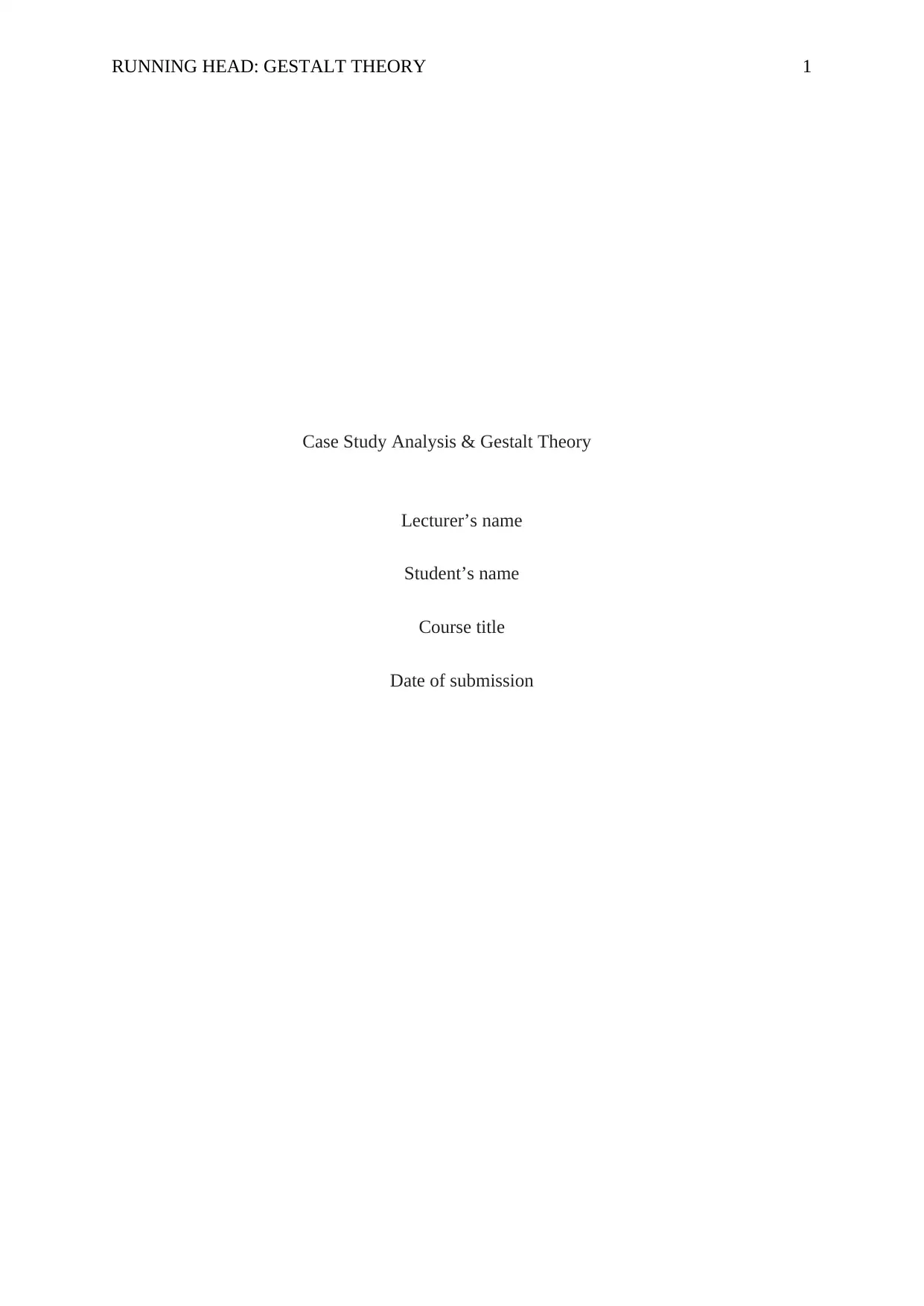
RUNNING HEAD: GESTALT THEORY 1
Case Study Analysis & Gestalt Theory
Lecturer’s name
Student’s name
Course title
Date of submission
Case Study Analysis & Gestalt Theory
Lecturer’s name
Student’s name
Course title
Date of submission
Secure Best Marks with AI Grader
Need help grading? Try our AI Grader for instant feedback on your assignments.
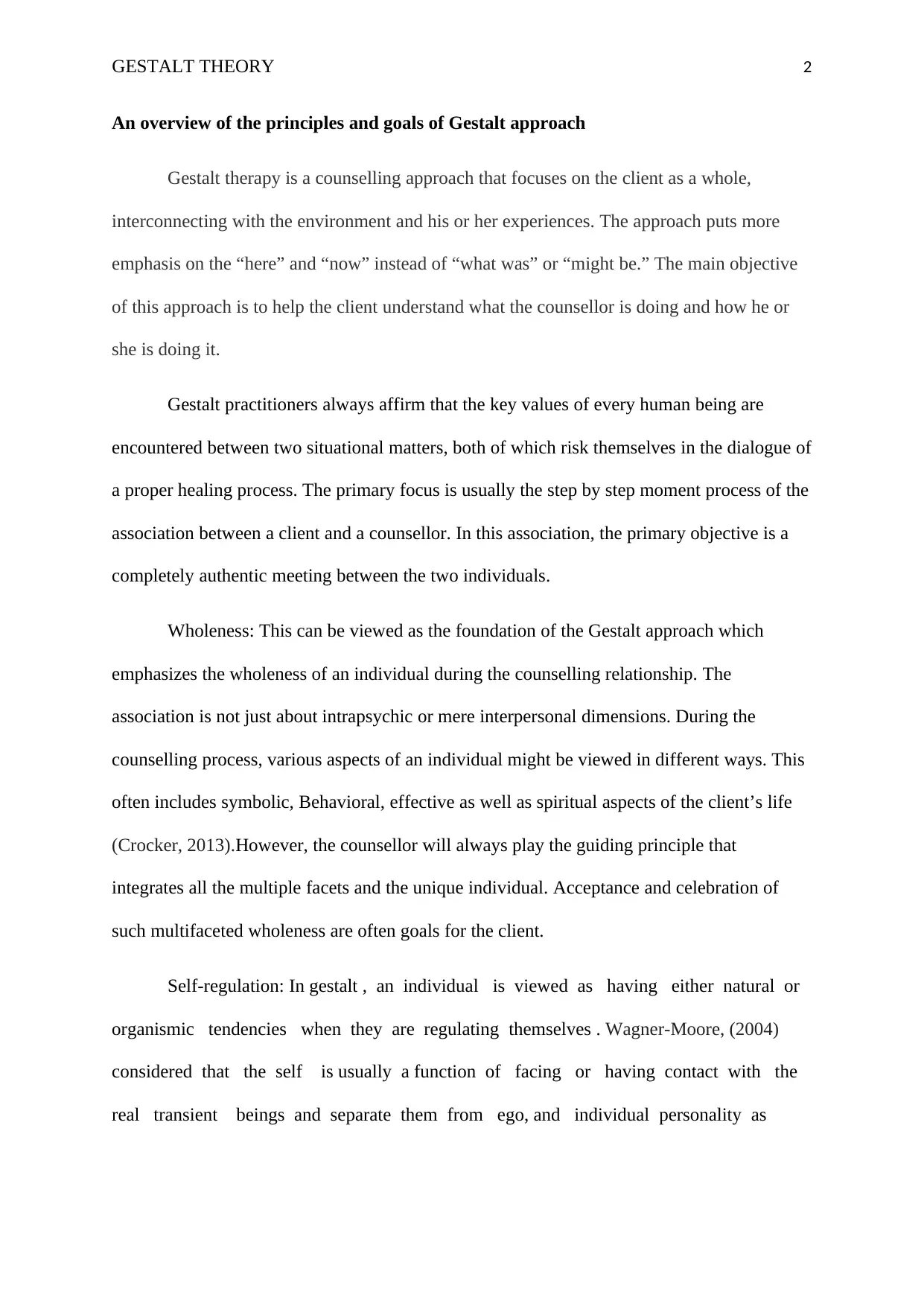
GESTALT THEORY 2
An overview of the principles and goals of Gestalt approach
Gestalt therapy is a counselling approach that focuses on the client as a whole,
interconnecting with the environment and his or her experiences. The approach puts more
emphasis on the “here” and “now” instead of “what was” or “might be.” The main objective
of this approach is to help the client understand what the counsellor is doing and how he or
she is doing it.
Gestalt practitioners always affirm that the key values of every human being are
encountered between two situational matters, both of which risk themselves in the dialogue of
a proper healing process. The primary focus is usually the step by step moment process of the
association between a client and a counsellor. In this association, the primary objective is a
completely authentic meeting between the two individuals.
Wholeness: This can be viewed as the foundation of the Gestalt approach which
emphasizes the wholeness of an individual during the counselling relationship. The
association is not just about intrapsychic or mere interpersonal dimensions. During the
counselling process, various aspects of an individual might be viewed in different ways. This
often includes symbolic, Behavioral, effective as well as spiritual aspects of the client’s life
(Crocker, 2013).However, the counsellor will always play the guiding principle that
integrates all the multiple facets and the unique individual. Acceptance and celebration of
such multifaceted wholeness are often goals for the client.
Self-regulation: In gestalt , an individual is viewed as having either natural or
organismic tendencies when they are regulating themselves . Wagner-Moore, (2004)
considered that the self is usually a function of facing or having contact with the
real transient beings and separate them from ego, and individual personality as
An overview of the principles and goals of Gestalt approach
Gestalt therapy is a counselling approach that focuses on the client as a whole,
interconnecting with the environment and his or her experiences. The approach puts more
emphasis on the “here” and “now” instead of “what was” or “might be.” The main objective
of this approach is to help the client understand what the counsellor is doing and how he or
she is doing it.
Gestalt practitioners always affirm that the key values of every human being are
encountered between two situational matters, both of which risk themselves in the dialogue of
a proper healing process. The primary focus is usually the step by step moment process of the
association between a client and a counsellor. In this association, the primary objective is a
completely authentic meeting between the two individuals.
Wholeness: This can be viewed as the foundation of the Gestalt approach which
emphasizes the wholeness of an individual during the counselling relationship. The
association is not just about intrapsychic or mere interpersonal dimensions. During the
counselling process, various aspects of an individual might be viewed in different ways. This
often includes symbolic, Behavioral, effective as well as spiritual aspects of the client’s life
(Crocker, 2013).However, the counsellor will always play the guiding principle that
integrates all the multiple facets and the unique individual. Acceptance and celebration of
such multifaceted wholeness are often goals for the client.
Self-regulation: In gestalt , an individual is viewed as having either natural or
organismic tendencies when they are regulating themselves . Wagner-Moore, (2004)
considered that the self is usually a function of facing or having contact with the
real transient beings and separate them from ego, and individual personality as
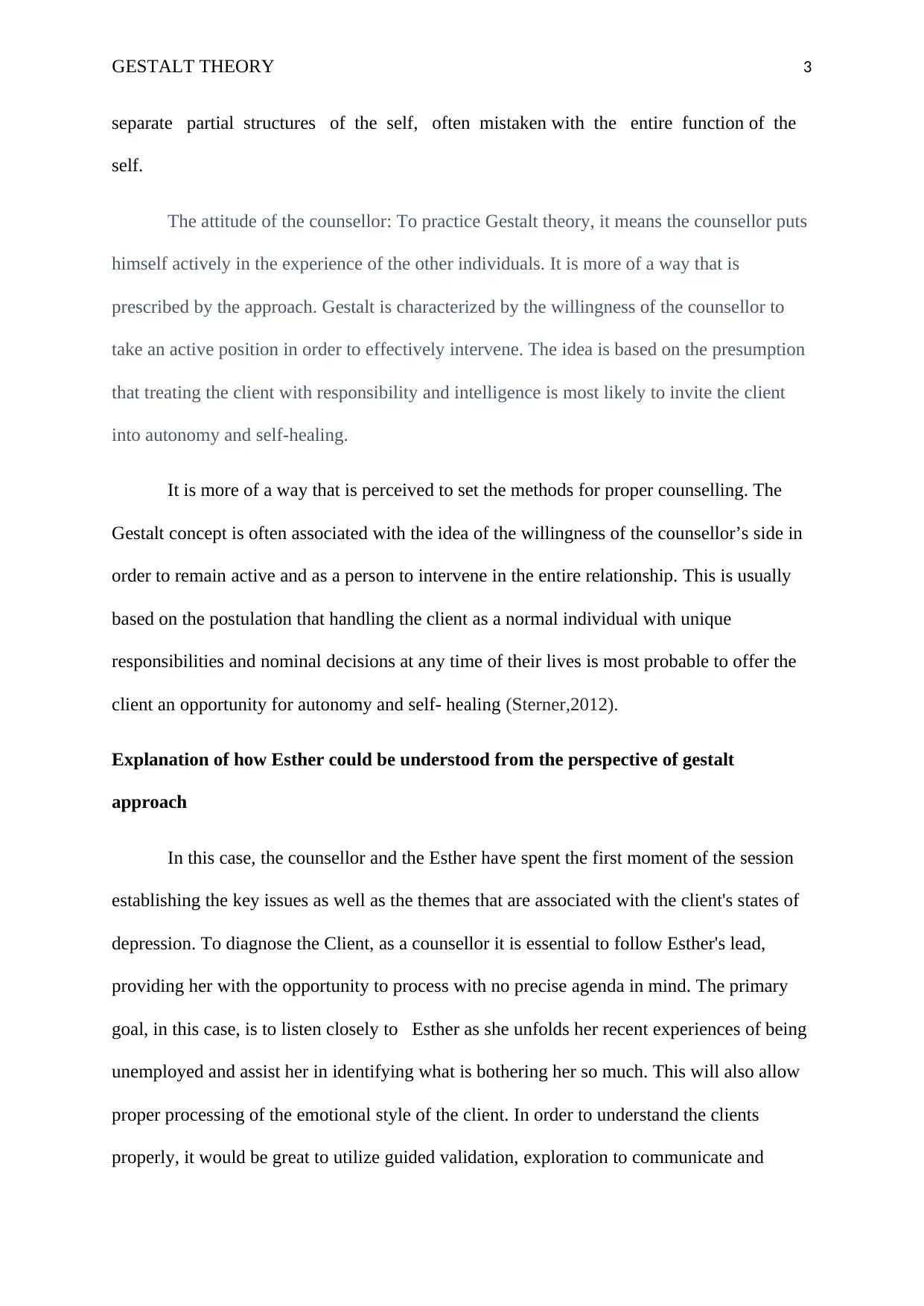
GESTALT THEORY 3
separate partial structures of the self, often mistaken with the entire function of the
self.
The attitude of the counsellor: To practice Gestalt theory, it means the counsellor puts
himself actively in the experience of the other individuals. It is more of a way that is
prescribed by the approach. Gestalt is characterized by the willingness of the counsellor to
take an active position in order to effectively intervene. The idea is based on the presumption
that treating the client with responsibility and intelligence is most likely to invite the client
into autonomy and self-healing.
It is more of a way that is perceived to set the methods for proper counselling. The
Gestalt concept is often associated with the idea of the willingness of the counsellor’s side in
order to remain active and as a person to intervene in the entire relationship. This is usually
based on the postulation that handling the client as a normal individual with unique
responsibilities and nominal decisions at any time of their lives is most probable to offer the
client an opportunity for autonomy and self- healing (Sterner,2012).
Explanation of how Esther could be understood from the perspective of gestalt
approach
In this case, the counsellor and the Esther have spent the first moment of the session
establishing the key issues as well as the themes that are associated with the client's states of
depression. To diagnose the Client, as a counsellor it is essential to follow Esther's lead,
providing her with the opportunity to process with no precise agenda in mind. The primary
goal, in this case, is to listen closely to Esther as she unfolds her recent experiences of being
unemployed and assist her in identifying what is bothering her so much. This will also allow
proper processing of the emotional style of the client. In order to understand the clients
properly, it would be great to utilize guided validation, exploration to communicate and
separate partial structures of the self, often mistaken with the entire function of the
self.
The attitude of the counsellor: To practice Gestalt theory, it means the counsellor puts
himself actively in the experience of the other individuals. It is more of a way that is
prescribed by the approach. Gestalt is characterized by the willingness of the counsellor to
take an active position in order to effectively intervene. The idea is based on the presumption
that treating the client with responsibility and intelligence is most likely to invite the client
into autonomy and self-healing.
It is more of a way that is perceived to set the methods for proper counselling. The
Gestalt concept is often associated with the idea of the willingness of the counsellor’s side in
order to remain active and as a person to intervene in the entire relationship. This is usually
based on the postulation that handling the client as a normal individual with unique
responsibilities and nominal decisions at any time of their lives is most probable to offer the
client an opportunity for autonomy and self- healing (Sterner,2012).
Explanation of how Esther could be understood from the perspective of gestalt
approach
In this case, the counsellor and the Esther have spent the first moment of the session
establishing the key issues as well as the themes that are associated with the client's states of
depression. To diagnose the Client, as a counsellor it is essential to follow Esther's lead,
providing her with the opportunity to process with no precise agenda in mind. The primary
goal, in this case, is to listen closely to Esther as she unfolds her recent experiences of being
unemployed and assist her in identifying what is bothering her so much. This will also allow
proper processing of the emotional style of the client. In order to understand the clients
properly, it would be great to utilize guided validation, exploration to communicate and
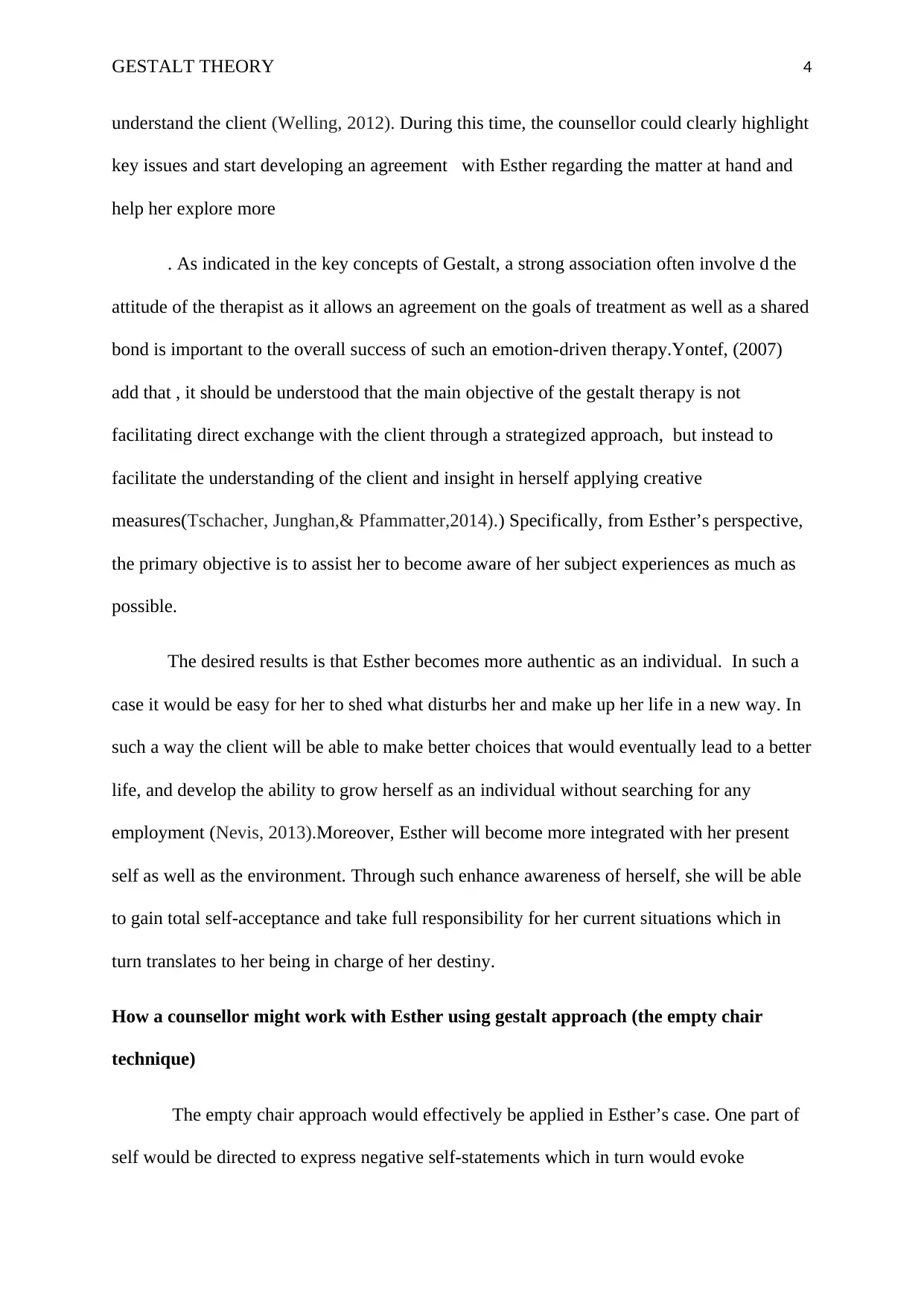
GESTALT THEORY 4
understand the client (Welling, 2012). During this time, the counsellor could clearly highlight
key issues and start developing an agreement with Esther regarding the matter at hand and
help her explore more
. As indicated in the key concepts of Gestalt, a strong association often involve d the
attitude of the therapist as it allows an agreement on the goals of treatment as well as a shared
bond is important to the overall success of such an emotion-driven therapy.Yontef, (2007)
add that , it should be understood that the main objective of the gestalt therapy is not
facilitating direct exchange with the client through a strategized approach, but instead to
facilitate the understanding of the client and insight in herself applying creative
measures(Tschacher, Junghan,& Pfammatter,2014).) Specifically, from Esther’s perspective,
the primary objective is to assist her to become aware of her subject experiences as much as
possible.
The desired results is that Esther becomes more authentic as an individual. In such a
case it would be easy for her to shed what disturbs her and make up her life in a new way. In
such a way the client will be able to make better choices that would eventually lead to a better
life, and develop the ability to grow herself as an individual without searching for any
employment (Nevis, 2013).Moreover, Esther will become more integrated with her present
self as well as the environment. Through such enhance awareness of herself, she will be able
to gain total self-acceptance and take full responsibility for her current situations which in
turn translates to her being in charge of her destiny.
How a counsellor might work with Esther using gestalt approach (the empty chair
technique)
The empty chair approach would effectively be applied in Esther’s case. One part of
self would be directed to express negative self-statements which in turn would evoke
understand the client (Welling, 2012). During this time, the counsellor could clearly highlight
key issues and start developing an agreement with Esther regarding the matter at hand and
help her explore more
. As indicated in the key concepts of Gestalt, a strong association often involve d the
attitude of the therapist as it allows an agreement on the goals of treatment as well as a shared
bond is important to the overall success of such an emotion-driven therapy.Yontef, (2007)
add that , it should be understood that the main objective of the gestalt therapy is not
facilitating direct exchange with the client through a strategized approach, but instead to
facilitate the understanding of the client and insight in herself applying creative
measures(Tschacher, Junghan,& Pfammatter,2014).) Specifically, from Esther’s perspective,
the primary objective is to assist her to become aware of her subject experiences as much as
possible.
The desired results is that Esther becomes more authentic as an individual. In such a
case it would be easy for her to shed what disturbs her and make up her life in a new way. In
such a way the client will be able to make better choices that would eventually lead to a better
life, and develop the ability to grow herself as an individual without searching for any
employment (Nevis, 2013).Moreover, Esther will become more integrated with her present
self as well as the environment. Through such enhance awareness of herself, she will be able
to gain total self-acceptance and take full responsibility for her current situations which in
turn translates to her being in charge of her destiny.
How a counsellor might work with Esther using gestalt approach (the empty chair
technique)
The empty chair approach would effectively be applied in Esther’s case. One part of
self would be directed to express negative self-statements which in turn would evoke
Secure Best Marks with AI Grader
Need help grading? Try our AI Grader for instant feedback on your assignments.
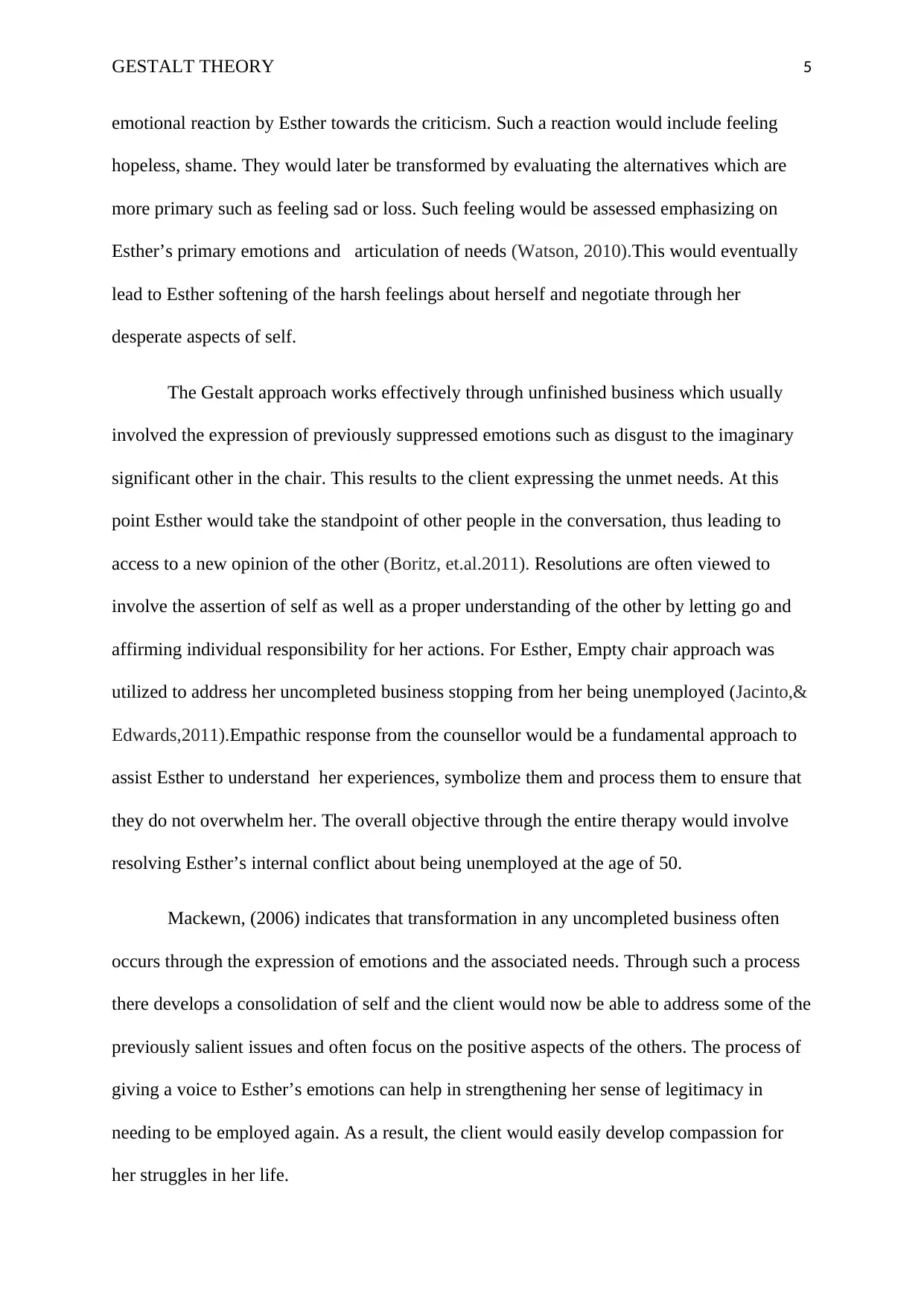
GESTALT THEORY 5
emotional reaction by Esther towards the criticism. Such a reaction would include feeling
hopeless, shame. They would later be transformed by evaluating the alternatives which are
more primary such as feeling sad or loss. Such feeling would be assessed emphasizing on
Esther’s primary emotions and articulation of needs (Watson, 2010).This would eventually
lead to Esther softening of the harsh feelings about herself and negotiate through her
desperate aspects of self.
The Gestalt approach works effectively through unfinished business which usually
involved the expression of previously suppressed emotions such as disgust to the imaginary
significant other in the chair. This results to the client expressing the unmet needs. At this
point Esther would take the standpoint of other people in the conversation, thus leading to
access to a new opinion of the other (Boritz, et.al.2011). Resolutions are often viewed to
involve the assertion of self as well as a proper understanding of the other by letting go and
affirming individual responsibility for her actions. For Esther, Empty chair approach was
utilized to address her uncompleted business stopping from her being unemployed (Jacinto,&
Edwards,2011).Empathic response from the counsellor would be a fundamental approach to
assist Esther to understand her experiences, symbolize them and process them to ensure that
they do not overwhelm her. The overall objective through the entire therapy would involve
resolving Esther’s internal conflict about being unemployed at the age of 50.
Mackewn, (2006) indicates that transformation in any uncompleted business often
occurs through the expression of emotions and the associated needs. Through such a process
there develops a consolidation of self and the client would now be able to address some of the
previously salient issues and often focus on the positive aspects of the others. The process of
giving a voice to Esther’s emotions can help in strengthening her sense of legitimacy in
needing to be employed again. As a result, the client would easily develop compassion for
her struggles in her life.
emotional reaction by Esther towards the criticism. Such a reaction would include feeling
hopeless, shame. They would later be transformed by evaluating the alternatives which are
more primary such as feeling sad or loss. Such feeling would be assessed emphasizing on
Esther’s primary emotions and articulation of needs (Watson, 2010).This would eventually
lead to Esther softening of the harsh feelings about herself and negotiate through her
desperate aspects of self.
The Gestalt approach works effectively through unfinished business which usually
involved the expression of previously suppressed emotions such as disgust to the imaginary
significant other in the chair. This results to the client expressing the unmet needs. At this
point Esther would take the standpoint of other people in the conversation, thus leading to
access to a new opinion of the other (Boritz, et.al.2011). Resolutions are often viewed to
involve the assertion of self as well as a proper understanding of the other by letting go and
affirming individual responsibility for her actions. For Esther, Empty chair approach was
utilized to address her uncompleted business stopping from her being unemployed (Jacinto,&
Edwards,2011).Empathic response from the counsellor would be a fundamental approach to
assist Esther to understand her experiences, symbolize them and process them to ensure that
they do not overwhelm her. The overall objective through the entire therapy would involve
resolving Esther’s internal conflict about being unemployed at the age of 50.
Mackewn, (2006) indicates that transformation in any uncompleted business often
occurs through the expression of emotions and the associated needs. Through such a process
there develops a consolidation of self and the client would now be able to address some of the
previously salient issues and often focus on the positive aspects of the others. The process of
giving a voice to Esther’s emotions can help in strengthening her sense of legitimacy in
needing to be employed again. As a result, the client would easily develop compassion for
her struggles in her life.
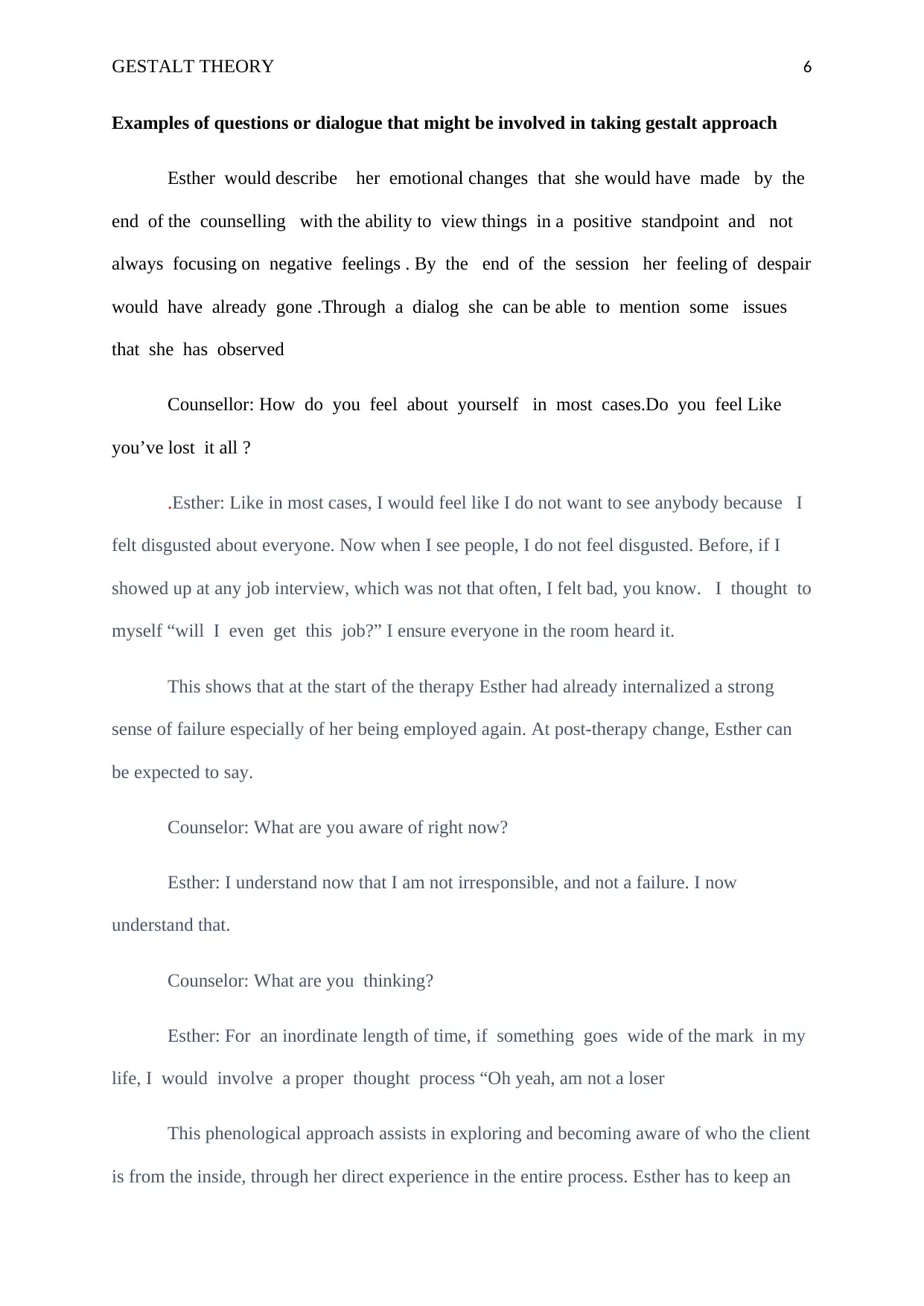
GESTALT THEORY 6
Examples of questions or dialogue that might be involved in taking gestalt approach
Esther would describe her emotional changes that she would have made by the
end of the counselling with the ability to view things in a positive standpoint and not
always focusing on negative feelings . By the end of the session her feeling of despair
would have already gone .Through a dialog she can be able to mention some issues
that she has observed
Counsellor: How do you feel about yourself in most cases.Do you feel Like
you’ve lost it all ?
.Esther: Like in most cases, I would feel like I do not want to see anybody because I
felt disgusted about everyone. Now when I see people, I do not feel disgusted. Before, if I
showed up at any job interview, which was not that often, I felt bad, you know. I thought to
myself “will I even get this job?” I ensure everyone in the room heard it.
This shows that at the start of the therapy Esther had already internalized a strong
sense of failure especially of her being employed again. At post-therapy change, Esther can
be expected to say.
Counselor: What are you aware of right now?
Esther: I understand now that I am not irresponsible, and not a failure. I now
understand that.
Counselor: What are you thinking?
Esther: For an inordinate length of time, if something goes wide of the mark in my
life, I would involve a proper thought process “Oh yeah, am not a loser
This phenological approach assists in exploring and becoming aware of who the client
is from the inside, through her direct experience in the entire process. Esther has to keep an
Examples of questions or dialogue that might be involved in taking gestalt approach
Esther would describe her emotional changes that she would have made by the
end of the counselling with the ability to view things in a positive standpoint and not
always focusing on negative feelings . By the end of the session her feeling of despair
would have already gone .Through a dialog she can be able to mention some issues
that she has observed
Counsellor: How do you feel about yourself in most cases.Do you feel Like
you’ve lost it all ?
.Esther: Like in most cases, I would feel like I do not want to see anybody because I
felt disgusted about everyone. Now when I see people, I do not feel disgusted. Before, if I
showed up at any job interview, which was not that often, I felt bad, you know. I thought to
myself “will I even get this job?” I ensure everyone in the room heard it.
This shows that at the start of the therapy Esther had already internalized a strong
sense of failure especially of her being employed again. At post-therapy change, Esther can
be expected to say.
Counselor: What are you aware of right now?
Esther: I understand now that I am not irresponsible, and not a failure. I now
understand that.
Counselor: What are you thinking?
Esther: For an inordinate length of time, if something goes wide of the mark in my
life, I would involve a proper thought process “Oh yeah, am not a loser
This phenological approach assists in exploring and becoming aware of who the client
is from the inside, through her direct experience in the entire process. Esther has to keep an
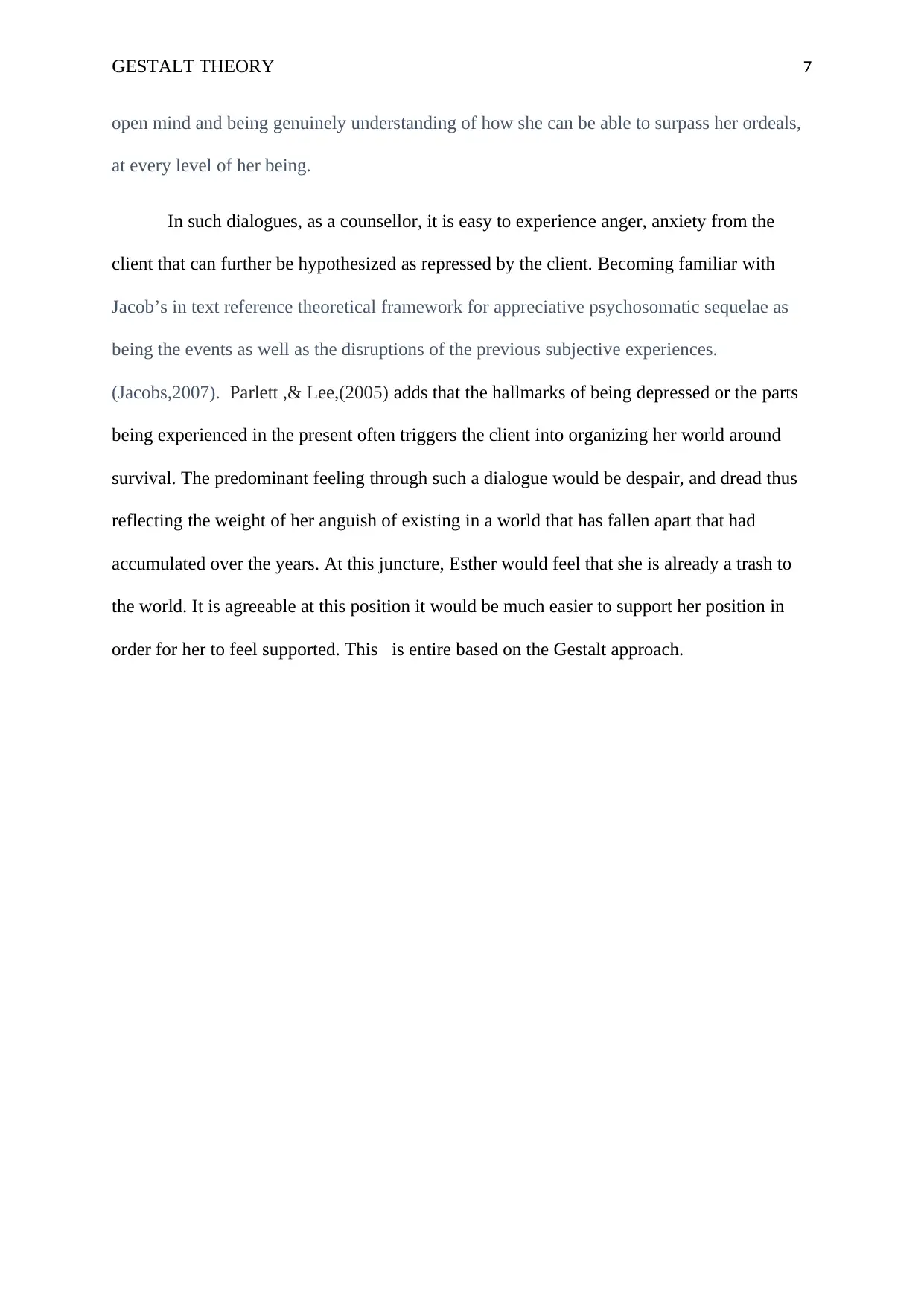
GESTALT THEORY 7
open mind and being genuinely understanding of how she can be able to surpass her ordeals,
at every level of her being.
In such dialogues, as a counsellor, it is easy to experience anger, anxiety from the
client that can further be hypothesized as repressed by the client. Becoming familiar with
Jacob’s in text reference theoretical framework for appreciative psychosomatic sequelae as
being the events as well as the disruptions of the previous subjective experiences.
(Jacobs,2007). Parlett ,& Lee,(2005) adds that the hallmarks of being depressed or the parts
being experienced in the present often triggers the client into organizing her world around
survival. The predominant feeling through such a dialogue would be despair, and dread thus
reflecting the weight of her anguish of existing in a world that has fallen apart that had
accumulated over the years. At this juncture, Esther would feel that she is already a trash to
the world. It is agreeable at this position it would be much easier to support her position in
order for her to feel supported. This is entire based on the Gestalt approach.
open mind and being genuinely understanding of how she can be able to surpass her ordeals,
at every level of her being.
In such dialogues, as a counsellor, it is easy to experience anger, anxiety from the
client that can further be hypothesized as repressed by the client. Becoming familiar with
Jacob’s in text reference theoretical framework for appreciative psychosomatic sequelae as
being the events as well as the disruptions of the previous subjective experiences.
(Jacobs,2007). Parlett ,& Lee,(2005) adds that the hallmarks of being depressed or the parts
being experienced in the present often triggers the client into organizing her world around
survival. The predominant feeling through such a dialogue would be despair, and dread thus
reflecting the weight of her anguish of existing in a world that has fallen apart that had
accumulated over the years. At this juncture, Esther would feel that she is already a trash to
the world. It is agreeable at this position it would be much easier to support her position in
order for her to feel supported. This is entire based on the Gestalt approach.
Paraphrase This Document
Need a fresh take? Get an instant paraphrase of this document with our AI Paraphraser
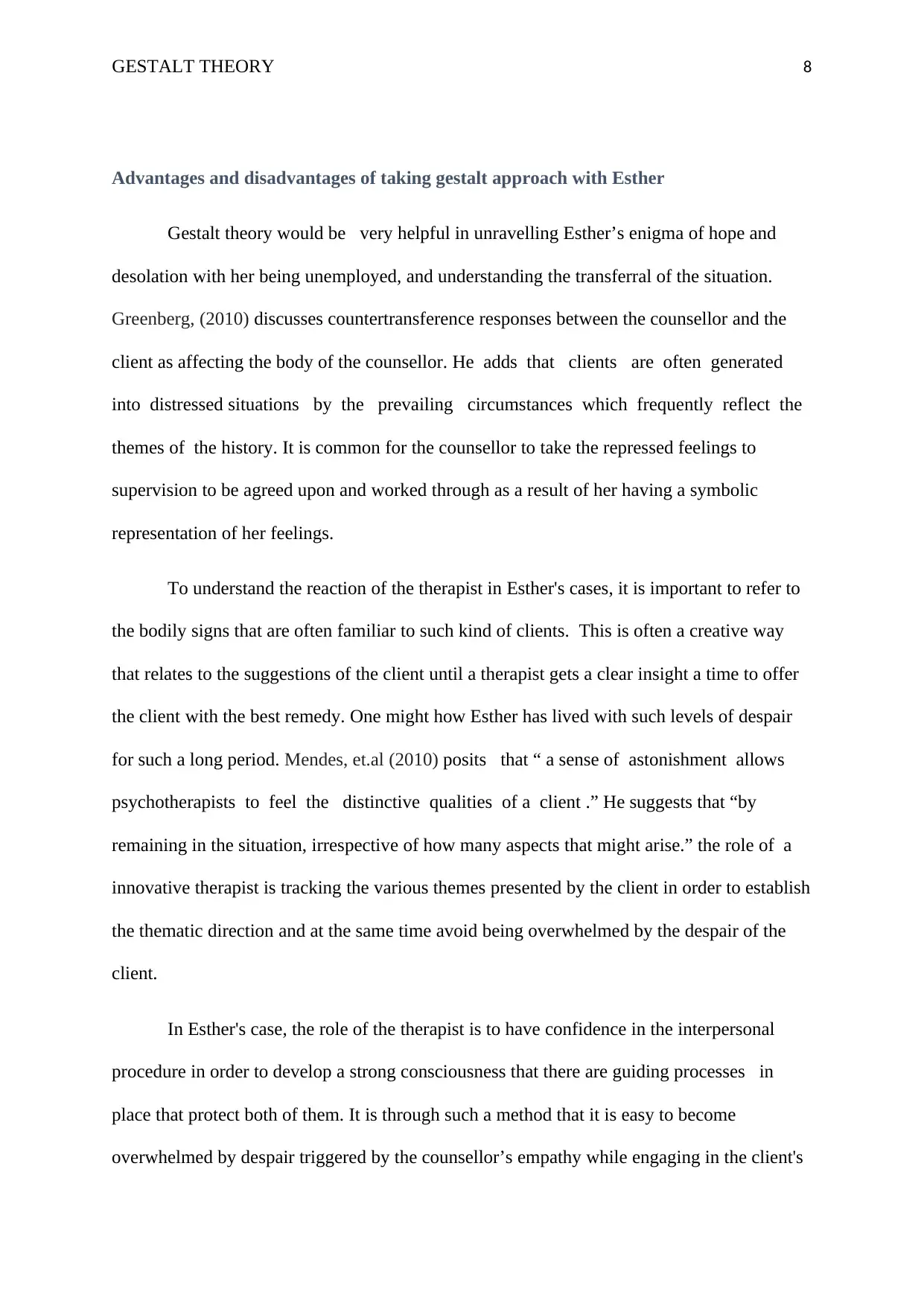
GESTALT THEORY 8
Advantages and disadvantages of taking gestalt approach with Esther
Gestalt theory would be very helpful in unravelling Esther’s enigma of hope and
desolation with her being unemployed, and understanding the transferral of the situation.
Greenberg, (2010) discusses countertransference responses between the counsellor and the
client as affecting the body of the counsellor. He adds that clients are often generated
into distressed situations by the prevailing circumstances which frequently reflect the
themes of the history. It is common for the counsellor to take the repressed feelings to
supervision to be agreed upon and worked through as a result of her having a symbolic
representation of her feelings.
To understand the reaction of the therapist in Esther's cases, it is important to refer to
the bodily signs that are often familiar to such kind of clients. This is often a creative way
that relates to the suggestions of the client until a therapist gets a clear insight a time to offer
the client with the best remedy. One might how Esther has lived with such levels of despair
for such a long period. Mendes, et.al (2010) posits that “ a sense of astonishment allows
psychotherapists to feel the distinctive qualities of a client .” He suggests that “by
remaining in the situation, irrespective of how many aspects that might arise.” the role of a
innovative therapist is tracking the various themes presented by the client in order to establish
the thematic direction and at the same time avoid being overwhelmed by the despair of the
client.
In Esther's case, the role of the therapist is to have confidence in the interpersonal
procedure in order to develop a strong consciousness that there are guiding processes in
place that protect both of them. It is through such a method that it is easy to become
overwhelmed by despair triggered by the counsellor’s empathy while engaging in the client's
Advantages and disadvantages of taking gestalt approach with Esther
Gestalt theory would be very helpful in unravelling Esther’s enigma of hope and
desolation with her being unemployed, and understanding the transferral of the situation.
Greenberg, (2010) discusses countertransference responses between the counsellor and the
client as affecting the body of the counsellor. He adds that clients are often generated
into distressed situations by the prevailing circumstances which frequently reflect the
themes of the history. It is common for the counsellor to take the repressed feelings to
supervision to be agreed upon and worked through as a result of her having a symbolic
representation of her feelings.
To understand the reaction of the therapist in Esther's cases, it is important to refer to
the bodily signs that are often familiar to such kind of clients. This is often a creative way
that relates to the suggestions of the client until a therapist gets a clear insight a time to offer
the client with the best remedy. One might how Esther has lived with such levels of despair
for such a long period. Mendes, et.al (2010) posits that “ a sense of astonishment allows
psychotherapists to feel the distinctive qualities of a client .” He suggests that “by
remaining in the situation, irrespective of how many aspects that might arise.” the role of a
innovative therapist is tracking the various themes presented by the client in order to establish
the thematic direction and at the same time avoid being overwhelmed by the despair of the
client.
In Esther's case, the role of the therapist is to have confidence in the interpersonal
procedure in order to develop a strong consciousness that there are guiding processes in
place that protect both of them. It is through such a method that it is easy to become
overwhelmed by despair triggered by the counsellor’s empathy while engaging in the client's
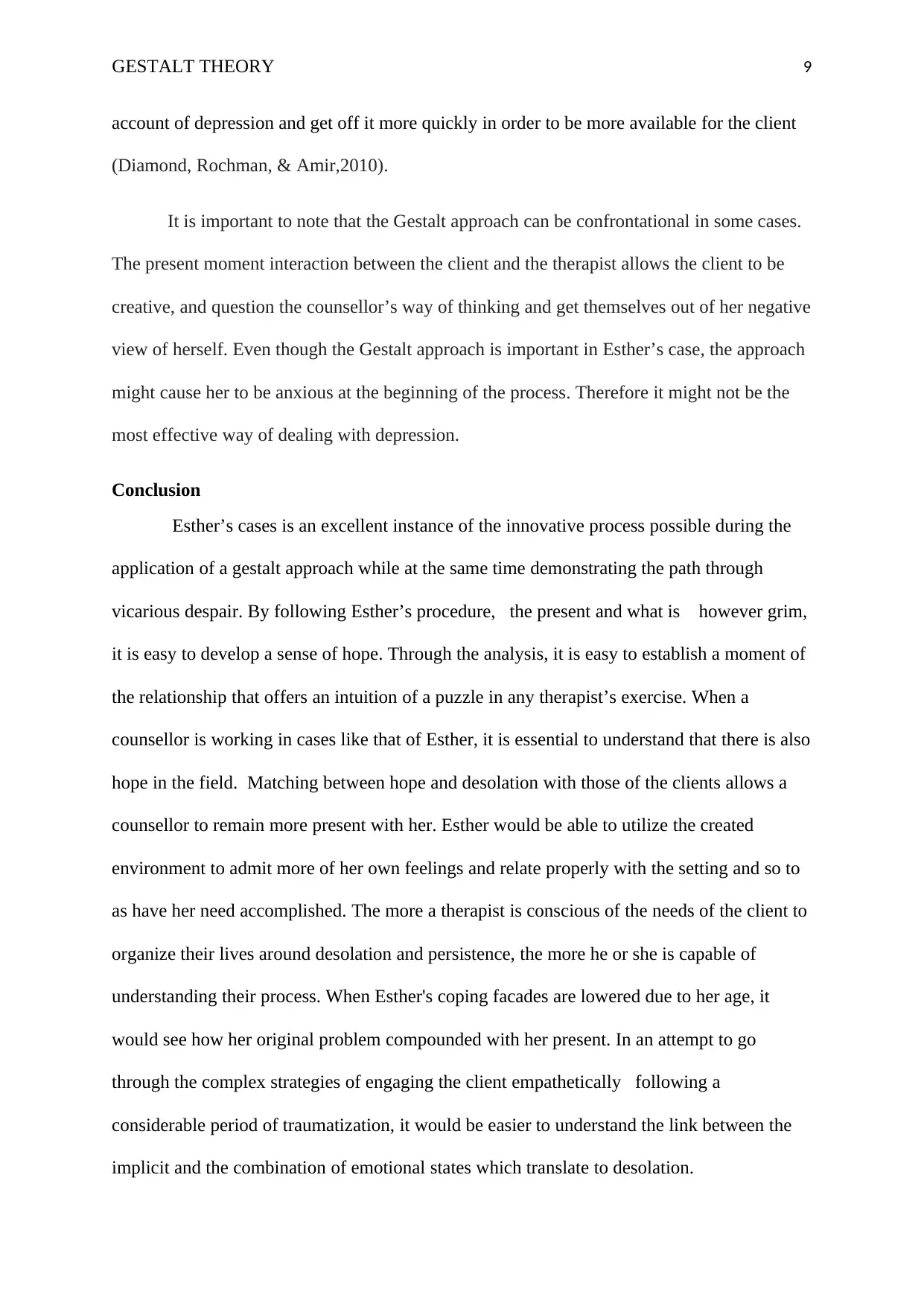
GESTALT THEORY 9
account of depression and get off it more quickly in order to be more available for the client
(Diamond, Rochman, & Amir,2010).
It is important to note that the Gestalt approach can be confrontational in some cases.
The present moment interaction between the client and the therapist allows the client to be
creative, and question the counsellor’s way of thinking and get themselves out of her negative
view of herself. Even though the Gestalt approach is important in Esther’s case, the approach
might cause her to be anxious at the beginning of the process. Therefore it might not be the
most effective way of dealing with depression.
Conclusion
Esther’s cases is an excellent instance of the innovative process possible during the
application of a gestalt approach while at the same time demonstrating the path through
vicarious despair. By following Esther’s procedure, the present and what is however grim,
it is easy to develop a sense of hope. Through the analysis, it is easy to establish a moment of
the relationship that offers an intuition of a puzzle in any therapist’s exercise. When a
counsellor is working in cases like that of Esther, it is essential to understand that there is also
hope in the field. Matching between hope and desolation with those of the clients allows a
counsellor to remain more present with her. Esther would be able to utilize the created
environment to admit more of her own feelings and relate properly with the setting and so to
as have her need accomplished. The more a therapist is conscious of the needs of the client to
organize their lives around desolation and persistence, the more he or she is capable of
understanding their process. When Esther's coping facades are lowered due to her age, it
would see how her original problem compounded with her present. In an attempt to go
through the complex strategies of engaging the client empathetically following a
considerable period of traumatization, it would be easier to understand the link between the
implicit and the combination of emotional states which translate to desolation.
account of depression and get off it more quickly in order to be more available for the client
(Diamond, Rochman, & Amir,2010).
It is important to note that the Gestalt approach can be confrontational in some cases.
The present moment interaction between the client and the therapist allows the client to be
creative, and question the counsellor’s way of thinking and get themselves out of her negative
view of herself. Even though the Gestalt approach is important in Esther’s case, the approach
might cause her to be anxious at the beginning of the process. Therefore it might not be the
most effective way of dealing with depression.
Conclusion
Esther’s cases is an excellent instance of the innovative process possible during the
application of a gestalt approach while at the same time demonstrating the path through
vicarious despair. By following Esther’s procedure, the present and what is however grim,
it is easy to develop a sense of hope. Through the analysis, it is easy to establish a moment of
the relationship that offers an intuition of a puzzle in any therapist’s exercise. When a
counsellor is working in cases like that of Esther, it is essential to understand that there is also
hope in the field. Matching between hope and desolation with those of the clients allows a
counsellor to remain more present with her. Esther would be able to utilize the created
environment to admit more of her own feelings and relate properly with the setting and so to
as have her need accomplished. The more a therapist is conscious of the needs of the client to
organize their lives around desolation and persistence, the more he or she is capable of
understanding their process. When Esther's coping facades are lowered due to her age, it
would see how her original problem compounded with her present. In an attempt to go
through the complex strategies of engaging the client empathetically following a
considerable period of traumatization, it would be easier to understand the link between the
implicit and the combination of emotional states which translate to desolation.

GESTALT THEORY 10
Secure Best Marks with AI Grader
Need help grading? Try our AI Grader for instant feedback on your assignments.
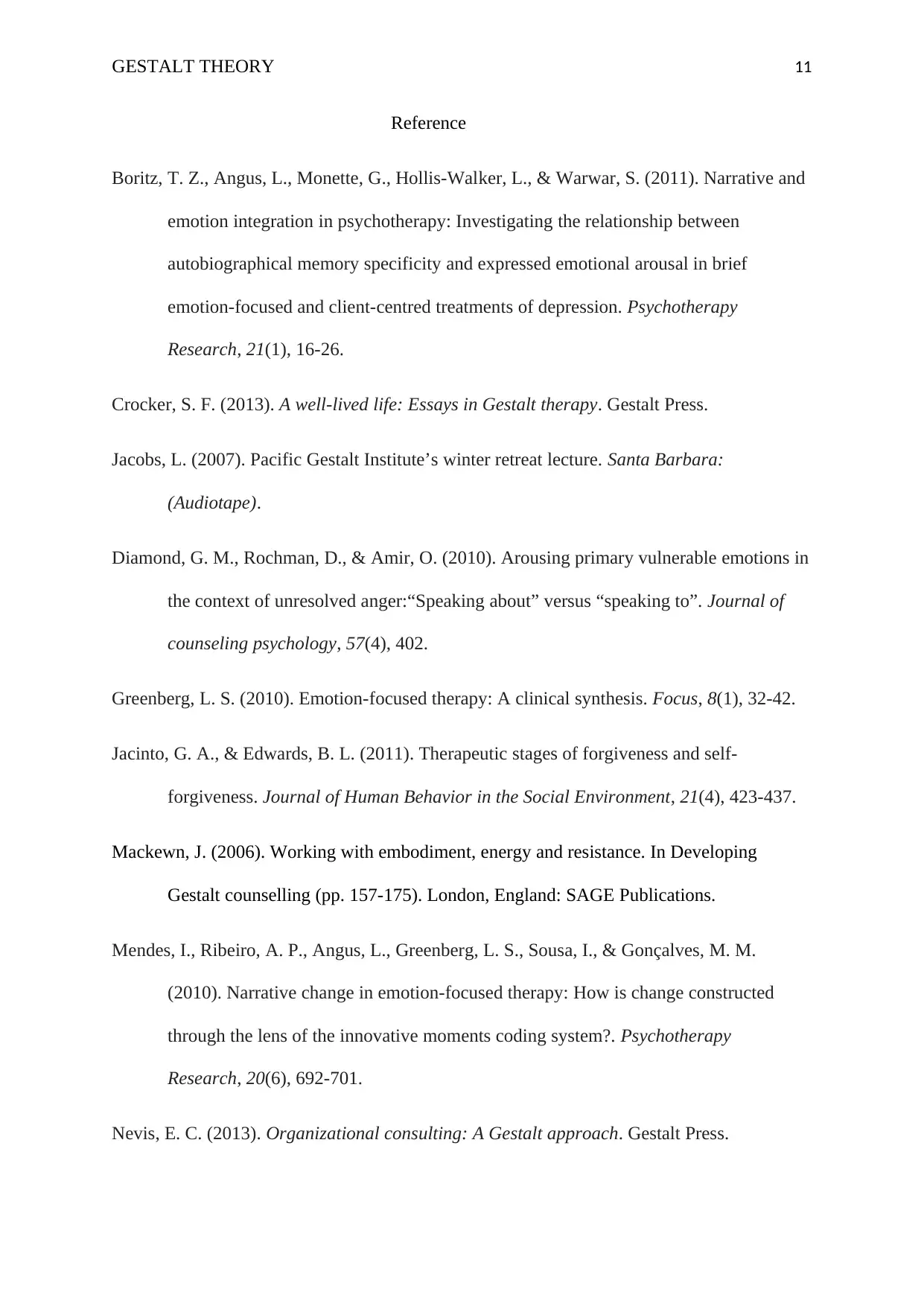
GESTALT THEORY 11
Reference
Boritz, T. Z., Angus, L., Monette, G., Hollis-Walker, L., & Warwar, S. (2011). Narrative and
emotion integration in psychotherapy: Investigating the relationship between
autobiographical memory specificity and expressed emotional arousal in brief
emotion-focused and client-centred treatments of depression. Psychotherapy
Research, 21(1), 16-26.
Crocker, S. F. (2013). A well-lived life: Essays in Gestalt therapy. Gestalt Press.
Jacobs, L. (2007). Pacific Gestalt Institute’s winter retreat lecture. Santa Barbara:
(Audiotape).
Diamond, G. M., Rochman, D., & Amir, O. (2010). Arousing primary vulnerable emotions in
the context of unresolved anger:“Speaking about” versus “speaking to”. Journal of
counseling psychology, 57(4), 402.
Greenberg, L. S. (2010). Emotion-focused therapy: A clinical synthesis. Focus, 8(1), 32-42.
Jacinto, G. A., & Edwards, B. L. (2011). Therapeutic stages of forgiveness and self-
forgiveness. Journal of Human Behavior in the Social Environment, 21(4), 423-437.
Mackewn, J. (2006). Working with embodiment, energy and resistance. In Developing
Gestalt counselling (pp. 157-175). London, England: SAGE Publications.
Mendes, I., Ribeiro, A. P., Angus, L., Greenberg, L. S., Sousa, I., & Gonçalves, M. M.
(2010). Narrative change in emotion-focused therapy: How is change constructed
through the lens of the innovative moments coding system?. Psychotherapy
Research, 20(6), 692-701.
Nevis, E. C. (2013). Organizational consulting: A Gestalt approach. Gestalt Press.
Reference
Boritz, T. Z., Angus, L., Monette, G., Hollis-Walker, L., & Warwar, S. (2011). Narrative and
emotion integration in psychotherapy: Investigating the relationship between
autobiographical memory specificity and expressed emotional arousal in brief
emotion-focused and client-centred treatments of depression. Psychotherapy
Research, 21(1), 16-26.
Crocker, S. F. (2013). A well-lived life: Essays in Gestalt therapy. Gestalt Press.
Jacobs, L. (2007). Pacific Gestalt Institute’s winter retreat lecture. Santa Barbara:
(Audiotape).
Diamond, G. M., Rochman, D., & Amir, O. (2010). Arousing primary vulnerable emotions in
the context of unresolved anger:“Speaking about” versus “speaking to”. Journal of
counseling psychology, 57(4), 402.
Greenberg, L. S. (2010). Emotion-focused therapy: A clinical synthesis. Focus, 8(1), 32-42.
Jacinto, G. A., & Edwards, B. L. (2011). Therapeutic stages of forgiveness and self-
forgiveness. Journal of Human Behavior in the Social Environment, 21(4), 423-437.
Mackewn, J. (2006). Working with embodiment, energy and resistance. In Developing
Gestalt counselling (pp. 157-175). London, England: SAGE Publications.
Mendes, I., Ribeiro, A. P., Angus, L., Greenberg, L. S., Sousa, I., & Gonçalves, M. M.
(2010). Narrative change in emotion-focused therapy: How is change constructed
through the lens of the innovative moments coding system?. Psychotherapy
Research, 20(6), 692-701.
Nevis, E. C. (2013). Organizational consulting: A Gestalt approach. Gestalt Press.
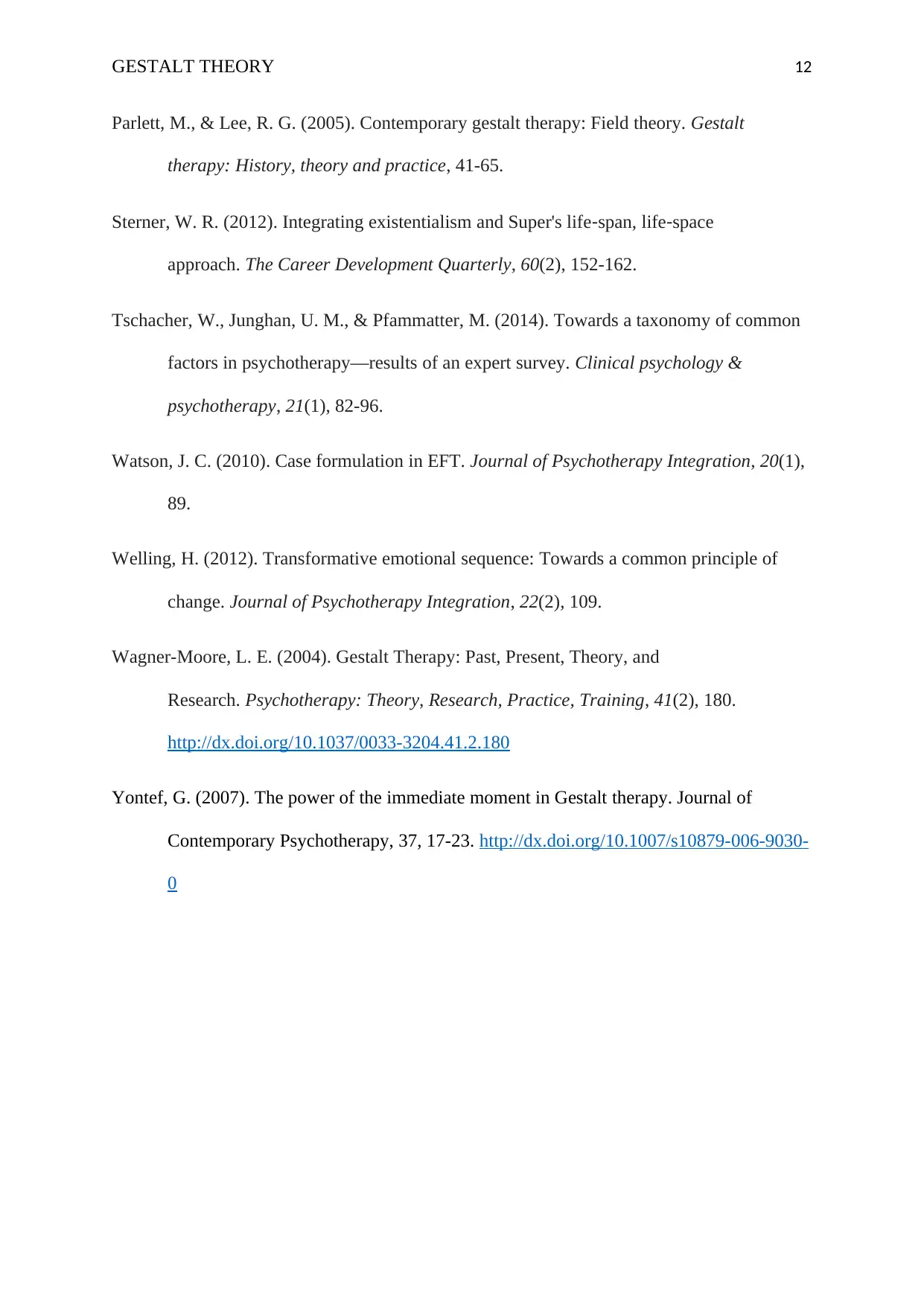
GESTALT THEORY 12
Parlett, M., & Lee, R. G. (2005). Contemporary gestalt therapy: Field theory. Gestalt
therapy: History, theory and practice, 41-65.
Sterner, W. R. (2012). Integrating existentialism and Super's life‐span, life‐space
approach. The Career Development Quarterly, 60(2), 152-162.
Tschacher, W., Junghan, U. M., & Pfammatter, M. (2014). Towards a taxonomy of common
factors in psychotherapy—results of an expert survey. Clinical psychology &
psychotherapy, 21(1), 82-96.
Watson, J. C. (2010). Case formulation in EFT. Journal of Psychotherapy Integration, 20(1),
89.
Welling, H. (2012). Transformative emotional sequence: Towards a common principle of
change. Journal of Psychotherapy Integration, 22(2), 109.
Wagner-Moore, L. E. (2004). Gestalt Therapy: Past, Present, Theory, and
Research. Psychotherapy: Theory, Research, Practice, Training, 41(2), 180.
http://dx.doi.org/10.1037/0033-3204.41.2.180
Yontef, G. (2007). The power of the immediate moment in Gestalt therapy. Journal of
Contemporary Psychotherapy, 37, 17-23. http://dx.doi.org/10.1007/s10879-006-9030-
0
Parlett, M., & Lee, R. G. (2005). Contemporary gestalt therapy: Field theory. Gestalt
therapy: History, theory and practice, 41-65.
Sterner, W. R. (2012). Integrating existentialism and Super's life‐span, life‐space
approach. The Career Development Quarterly, 60(2), 152-162.
Tschacher, W., Junghan, U. M., & Pfammatter, M. (2014). Towards a taxonomy of common
factors in psychotherapy—results of an expert survey. Clinical psychology &
psychotherapy, 21(1), 82-96.
Watson, J. C. (2010). Case formulation in EFT. Journal of Psychotherapy Integration, 20(1),
89.
Welling, H. (2012). Transformative emotional sequence: Towards a common principle of
change. Journal of Psychotherapy Integration, 22(2), 109.
Wagner-Moore, L. E. (2004). Gestalt Therapy: Past, Present, Theory, and
Research. Psychotherapy: Theory, Research, Practice, Training, 41(2), 180.
http://dx.doi.org/10.1037/0033-3204.41.2.180
Yontef, G. (2007). The power of the immediate moment in Gestalt therapy. Journal of
Contemporary Psychotherapy, 37, 17-23. http://dx.doi.org/10.1007/s10879-006-9030-
0
1 out of 12
Related Documents
Your All-in-One AI-Powered Toolkit for Academic Success.
+13062052269
info@desklib.com
Available 24*7 on WhatsApp / Email
![[object Object]](/_next/static/media/star-bottom.7253800d.svg)
Unlock your academic potential
© 2024 | Zucol Services PVT LTD | All rights reserved.

